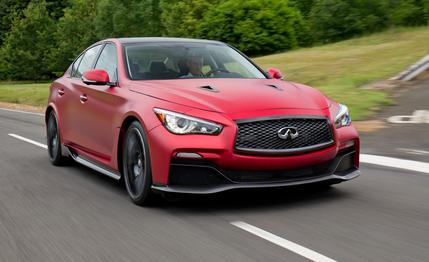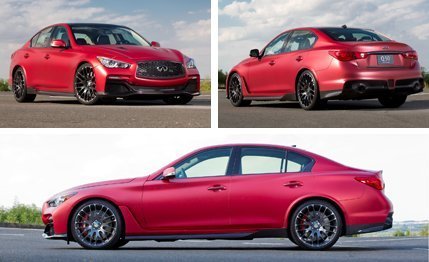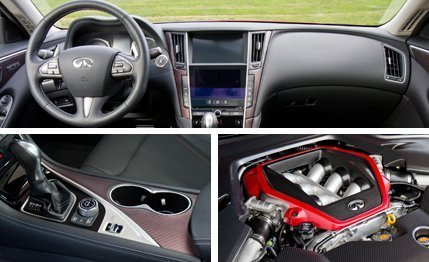 First Drive Review
First Drive Review
“We want to know what you think,” said the polite fellows in custody of Infiniti’s recently completed—and only—Q50 Eau Rouge prototype. This is very flattering to a writer, the implication that my opinion might be relevant to some important decisions in, say, the final suspension tune or even whether or not to build the car in the first place. I told them I’m the wrong guy to ask about that, as I’m firmly in favor of sticking GT-R engines in everything that Nissan makes, including its forklifts. So a four-door Nissan GT-R? Yes, please. Build that.
Infusing a Q50 sedan with GT-R guts isn’t quite as easy as fabbing up some new motor mounts, as I discovered at the Millbrook Proving Ground in England. The twin-turbocharged 3.8-liter V-6 itself fits quite nicely, but everything else is sort of an engineering nightmare. The GT-R, it seems, has a much longer nose than the Q50, so the Eau Rouge needed all new front bodywork to accommodate the cooling apparatus for the 560-hp furnace pushed against the firewall. When I first saw the car, I thought it had some sort of police-style strobe lights behind the grille. It turned out I was looking at the intercoolers, which are tucked right up front.
The drivetrain presents more challenges. In its current guise, the Eau Rouge is running the seven-speed torque-converter automatic from the V-8–powered Q70, along with the Q70’s all-wheel-drive system. Infiniti asked that we use the paddle shifters to manually change gears, in the interest of transmission preservation. And gearchanges were programmed to take a while—again, with the hopes that this transmission would last long enough to survive the attentions of a few writers turned loose on Millbrook’s alpine loops.

Until recently, the prototype was running Infiniti’s steer-by-wire system, which was swapped for a conventional electric-assist helm to see how that would work. Hence the steering-system warning light on the dash. It wouldn’t be a prototype without a few constantly illuminated warning lights.
The car has been fitted with a specially made limited-slip rear differential—the only thing on the Eau Rouge not from the corporate parts counter—since Infiniti quickly concluded that open diffs weren’t going to cut it with 560 horsepower, all-wheel drive or not. Strangely, I kept lighting up the inside rear tire coming out of one particular corner, which may have been due to the track’s undulating pavement. Or it could have just been that the diff didn’t work. Infiniti, for its part, says that it hasn’t replicated the behavior.
But you can’t judge a car like this the way you would a production car or even a development mule. This is not intended to be the last word on Eau Rouge setup, although its makers would do well to keep the suspension—with new adjustable coil-overs up front—right where it is. It strikes a great balance between compliance and poise, which is appropriate for the four-door audience. No matter how unholy fast this thing is in a straight line, sedan buyers probably don’t want their innards vibrated on the GT-R frequency.

So, the track: The loop covers about three miles, and it’s designed not for enjoyment but to torment cars into revealing their weaknesses. There are a few sections where a brake-tap is mandatory to prevent serious air, as on the “Jaguar corner,” so named because it sent a Jaguar airborne into some trees. And the section named “ski jump” is self-explanatory. As for runoff, there are a generous few inches of it here and there, right before the guardrail. Now let’s go drive that priceless prototype!
Looking out over the hood, with its GT-R–style vents, you can fool yourself into thinking you’re in Nissan’s supercar rather than Infiniti’s possible flagship sedan. Ditto when you roll on the throttle and get a real taste of the 3.8’s talents; that signature intake whoosh paired with brutal acceleration tells your brain this is a GT-R. It didn’t always seem to release full power—either due to traction control or maybe torque modulation in the name of transmission survival—but when it did, it scrolled the scenery as hard as you’d expect.
So the power was there. Putting it down is still a work in progress, I think. The Q70’s all-wheel-drive system isn’t exactly performance-oriented, so the Eau Rouge sends about 50 percent of its power to the front end. A rear torque bias seems like a must for a car such as this.

The tires are another area that might require some tinkering. They’re 255s all the way around. A square setup is great for snubbing understeer—see: “Z28, Camaro”—but a 4000-pound car with 560 horsepower probably needs wider rubber than this, at least at the back. The Eau Rouge displayed wonderful agility with instant turn-in, but I think that might be an artifact of the rear-diff behavior along with the relative lack of grip at the back end. But that’s the kind of thing they’d sort out over the next 18 months or so, should this car go to production. My takeaway: Please retain that agility but add some ultimate grip. Plus—big, wide tires look cool.
I imagine that in its production form, the Eau Rouge will have a more sophisticated AWD system, perhaps a different limited-slip rear end, wider tires, and possibly some sort of brake-based torque vectoring, which can work wonders on all-wheel-drive cars. They should keep the great Recaros, keep the GT-R brakes, keep the suspension tune, and definitely keep the GT-R V-6 (both the Q70 V-8 and a supercharged 3.7-liter V-6 were considered).
And that, Infiniti, is my valuable, valuable input. Here’s to hoping that, come the 2016 model year, Infiniti’s first real superstar is more than just a prototype.